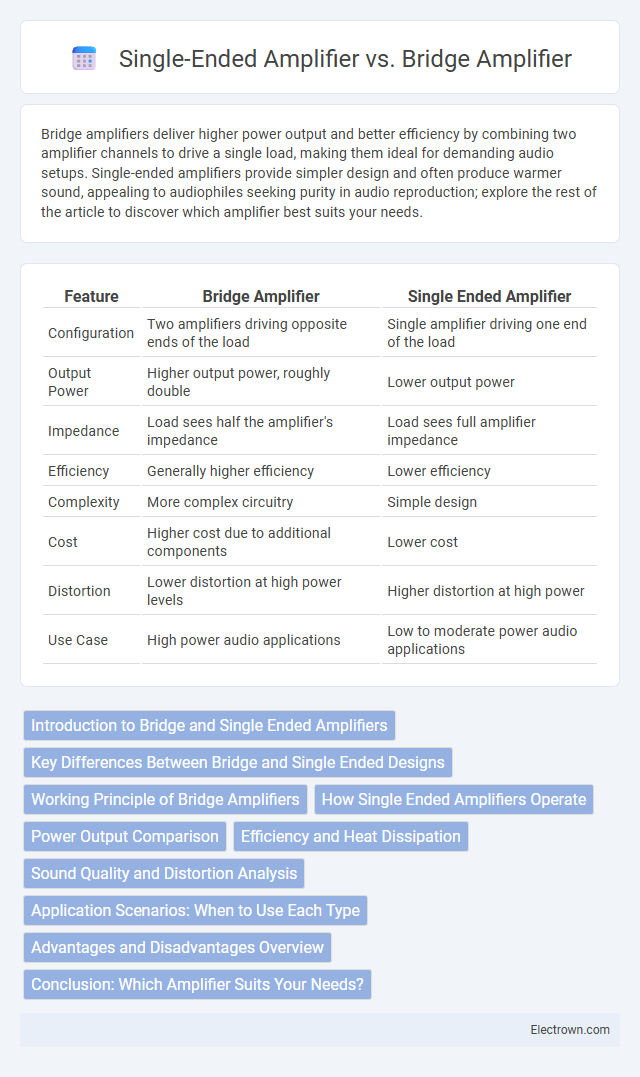Bridge amplifiers deliver higher power output and better efficiency by combining two amplifier channels to drive a single load, making them ideal for demanding audio setups. Single-ended amplifiers provide simpler design and often produce warmer sound, appealing to audiophiles seeking purity in audio reproduction; explore the rest of the article to discover which amplifier best suits your needs.
Table of Comparison
| Feature | Bridge Amplifier | Single Ended Amplifier |
|---|---|---|
| Configuration | Two amplifiers driving opposite ends of the load | Single amplifier driving one end of the load |
| Output Power | Higher output power, roughly double | Lower output power |
| Impedance | Load sees half the amplifier's impedance | Load sees full amplifier impedance |
| Efficiency | Generally higher efficiency | Lower efficiency |
| Complexity | More complex circuitry | Simple design |
| Cost | Higher cost due to additional components | Lower cost |
| Distortion | Lower distortion at high power levels | Higher distortion at high power |
| Use Case | High power audio applications | Low to moderate power audio applications |
Introduction to Bridge and Single Ended Amplifiers
Bridge amplifiers use two amplifier channels to drive a load differentially, effectively doubling the output voltage and quadrupling power output compared to single-ended amplifiers. Single-ended amplifiers operate with one active device per channel, delivering lower power and simpler circuitry but with increased distortion and limited efficiency. The bridge design excels in high-power audio applications, whereas single-ended amps are favored for their simplicity and characteristic sound quality.
Key Differences Between Bridge and Single Ended Designs
Bridge amplifiers deliver higher power output by using two amplifier channels driving opposite ends of a load, effectively doubling the voltage swing across the speaker, whereas single-ended amplifiers use a single output stage driving the load directly. Bridge designs typically offer improved efficiency and reduced distortion at higher power levels but involve more complex circuitry and potentially higher crossover distortion. Single-ended amplifiers are known for their simpler design and distinctive warm sound, favored in high-fidelity audio applications despite producing lower power and increased harmonic distortion compared to bridge configurations.
Working Principle of Bridge Amplifiers
Bridge amplifiers operate by using two amplifier channels to drive a single load differentially, where one amplifier outputs the positive signal and the other outputs the inverted signal, effectively doubling the voltage swing across the load. This push-pull configuration increases the output power without requiring a higher supply voltage, enhancing efficiency and power handling. The differential operation also reduces distortion and improves overall audio performance compared to single-ended amplifiers that drive the load from a single output stage referenced to ground.
How Single Ended Amplifiers Operate
Single Ended Amplifiers operate by using a single transistor or tube to amplify the entire audio waveform, producing a simpler design with low distortion and a warm, natural sound. This operation contrasts with Bridge Amplifiers, which use two amplifiers to drive the load differentially, resulting in higher power output and efficiency. Your choice depends on whether you prioritize purity of sound or maximum power delivery.
Power Output Comparison
Bridge amplifiers provide significantly higher power output compared to single-ended amplifiers by effectively doubling the voltage swing across the load, resulting in up to four times the power delivery. Single-ended amplifiers, limited by their single transistor or tube stage, typically produce lower wattage, making them suitable for low-power applications. Bridge configurations are preferred in high-power audio systems where maximizing power and efficiency is critical.
Efficiency and Heat Dissipation
Bridge amplifiers typically deliver higher efficiency by effectively doubling the output voltage swing across the load, resulting in increased power output without a proportional rise in current, which reduces heat generation. Single-ended amplifiers, while simpler in design, operate with a constant current flow through the output device, leading to lower efficiency and greater heat dissipation. Efficient heat management in bridge amplifiers enables enhanced performance and reliability in high-power audio applications compared to single-ended designs.
Sound Quality and Distortion Analysis
Bridge amplifiers deliver higher power output and improved dynamic range, resulting in louder and more impactful sound with reduced distortion at higher volumes. Single-ended amplifiers are often praised for their warm, natural sound but typically exhibit higher distortion levels, especially harmonic distortion, due to their simpler circuit design. Your choice depends on whether you prioritize raw power with cleaner sound or the distinctive tonal character associated with single-ended designs.
Application Scenarios: When to Use Each Type
Bridge amplifiers excel in automotive and high-power home audio systems due to their ability to deliver double the output voltage and increased power efficiency, making them ideal for driving subwoofers and large speakers. Single-ended amplifiers suit low-power, high-fidelity contexts such as headphone amplifiers and small-scale audio devices, providing simplicity and lower distortion. Choosing between these depends on power requirements, space constraints, and audio performance goals specific to the application scenario.
Advantages and Disadvantages Overview
Bridge amplifiers deliver higher power output by driving speakers with two amplifier channels in a push-pull configuration, maximizing efficiency and reducing distortion. Single-ended amplifiers offer simpler design and better linearity at low power levels, resulting in warmer sound quality but lower overall power and efficiency. Bridge amplifiers can generate more heat and require precise matching of components, whereas single-ended amps are prone to higher distortion and limited dynamic range.
Conclusion: Which Amplifier Suits Your Needs?
Bridge amplifiers deliver higher power output and better efficiency, making them ideal for driving large speakers or subwoofers in home theater or car audio systems. Single-ended amplifiers produce clearer, warmer sound with lower distortion, preferred for audiophiles seeking high-fidelity and nuanced audio reproduction. Your choice depends on whether you prioritize raw power and volume or sonic purity and detailed listening experience.
bridge amplifier vs single ended amplifier Infographic

 electrown.com
electrown.com